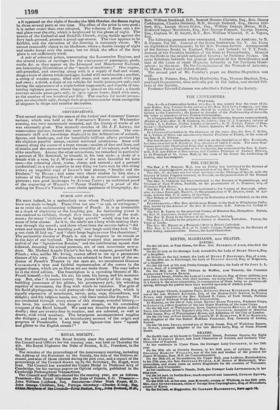NEW PRINTS.
" The Bitter Morning."—What a refrigerator ! the sight of this print would be as good as an ice in summer. We should be fearful of catching an ague by looking too long at it on a hot day. But now, it is season- able ; it is only one more morning misery. How we sympathize with. the shuddering wight whose nose emerges from a heap of bed-clothes, his tasselled night-cap forming the apex of a pyramid of white counterpane ! He glances furtively with horrible anticipations at the frosted window- panes, against which the steam of his " shaving-water " rises, making the prospect more dreary by contrast ; and his resolution seems frozen. In the painting, the artist gave the spectator a peep into the ante-room, where a blazing fire and the apparatus of breakfast cheered the sight; but in the print, the door is shut, and a pair of furred slippers is the only mitigating object in the scene. Mr. Tnostas FAIRLAND has lithographed the print with ability, and fidelity also : his tints are, however, heavy and deficient in variety of colour ; and there is a lack of depth, force, and clearness in the effect. These qualities especially belong to Mr. Buss's style, and are therefore missed the more. " The Lam leading the Blind" is a canine version of the proverb, by Mr. HA/woes ; who has told the incident well. Two terriers, the white one lame, and the brown one blind, are linked together ; and the white one, espying a tempting viand, limps eagerly to seize it, unmindful of his dark yoke-fellow, who, not being able to see his way, has run on the other side of a scraper, on which the chain is entangled. The expression of both dogs is natural, and the print is altogether a very good one ; but Mr. HANCOCK'S dogs are not equal to those of EDWIN L _ANDSEER. He does not succeed so completely in imitating the glossy sleekness of their coats, nor in giving that appearance of hair which his rival :so emi- nently excels in representing. Neither are they in other respects drawn with that force and nature which distinguish the dogs of LANDSEER. The print is, however, an excellent work of art ; and the engraver, H. BECKWITH, has done his part admirably.
H. C. SLous has made a lithographic drawing of CHANTREY'S statue of Pitt, lately erected in Hanover Square. It is a good resemblance in all respects but the face. A very neat engraving, by J. B. FORREST, of Barmes bust of Sto- thard, gives to the venerable artist an expression of ill-humour which does not belong to his physiognomy, and which is foreign to his nature.
The terrible occurrences at Bristol have furnished to the artist a scene of fearful grandeur, which, by the aid of lithography, has been already put before the public. The drawing on the stone is by L. HAGHE, from the original by THOMAS L. EQWBOTHAN. It represents the city of Bristol
it appeared on the night of Sunday the 30th-October, the flames raging in three several parts.at one time. The effect of the print is very good; it is rather under than over coloured. The volumes of flame cast a dis- mal glare over the city, which is heightened by the gloom of night. The towers of the Cathedral and Redelitie Church, rising darkly against the fiery back-ground, present a grand appearance. The view appears to be faithful, and the execution of the drawing is extremely clever. We cannot reasonably object to its blackness, where a double canopy of night and smoke hangs over the scene; but we think the effect of the fiery glare is not sufficiently vivid. A pair of coloured prints, representing the Locomotive Engines, and the several trains of carriages for the conveyance of passengers, goods, cattle, &c. as they appear on the Liverpool and Manchester Railroad, are interesting illustrations of the "march of machinery." One engine, self-propelled, and. carrying along with it a supply of fuel and water, drags a train of eleven truck-carriages, loaded with merchandise ; another, n string of wooden cages, filled with sheep, and open pounds with pigs and oxen ; a third, a train of six vehicles for inside passengers only, each having the appearance of a triple-bodied stage-coach, and capable of con- taining eighteen persons, whose luggage is placed on the roof ; a fourth conveys outside passengers only, in open square boxes, fitted with seats, to the number of one hundred and fifty. The coaches for inside passen- gers are singularly ugly, though their proportions render them susceptible of elegance in shape and exterior decoration.



























 Previous page
Previous page